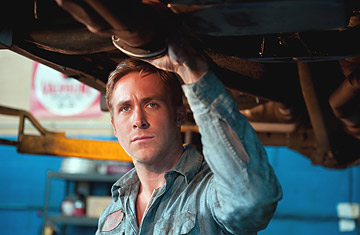
Ryan Gosling in Drive
Ryan Gosling! Man or machine? Myth or miracle? Is there anything he can't do? He's George Clooney's heir apparent! He breaks up street fights on his way home from the gym! He has Photoshopped abs! He's the subject of the best Tumblr ever! He's the guy from The Notebook! But there's more and yet more; he contains multitudes. There is romantic Gosling (Crazy Stupid Love) and edgy Method Gosling (The Believer) and quirky indie Gosling (Lars and the Real Girl) and lumpen burnout Gosling (Blue Valentine) and psycho killer Gosling (Murder by Numbers).
But who is Gosling qua Gosling? What is Gosling boiled down to purest Goslingness? What if there were a filmed entertainment that gave Gosling few words, fewer motivations and fewest expressions? Would these distilled vapors of the Gosling essence combust, causing fires in our theaters, swooning in our streets, hysterical blindness in our children? And would it matter that in this filmed entertainment, he doesn't take his shirt off even once?
Drive, a gleaming, goofy action-thriller from Danish director Nicolas Winding Refn, is the first Goslingwerk to formulate Minimalist Gosling. He plays a near mute stuntman with a lucrative sideline as the getaway driver for robberies (the sinuous opening sequence lays out his command of nocturnal L.A. streets, cop-chase geography and — crucially for his thieving passengers — the Clippers' home-game schedule). He has no friends, though he does have a squirrely employer (Bryan Cranston) who's in deep with a sulfurous gangster (Hellboy's Ron Perlman) and his ex-movie-producer associate (Albert Brooks, brilliantly cast). He has no girl of his own; he's smitten with the wistful mom down the hall (Carey Mulligan), but her husband is about to return home from prison. And he has no name, perhaps because there are too many names to choose from: "Driver" (as the credits call him) evokes the taciturn loner heroes of Eastwood, McQueen and the eponym of Walter Hill's The Driver (1978).
Like Gosling's Driver, Drive is to a great extent the sum of its influences. Refn, who has a passionate cult following and some unlikely art-house cred for his deliriously violent Pusher trilogy and Bronson, is a child of the 1980s. For him, To Live and Die in L.A. and the collected works of Michael Mann are sacred texts to be restaged (more slo-mo! More blood! More crunching of bone!) and Goslingized. If '80s axiom Molly Ringwald had a custom font, it would be the jagged pink cursive of Drive's opening titles. Even the pop songs have the cocaine-cheesy sheen of a synth power ballad from the Miami Vice soundtrack. Minimalist Gosling has a heart, and it beats to a drum machine.
That heart is big and strong and selfless! But it can express itself only through wicked steering maneuvers, fisticuffs and placid TV-watching with Mulligan's son. And crime: to get her hubby out of a pinch, Gosling agrees to a pro bono heist that goes awry as expected, leaving him holding a bag full of Perlman's and Brooks' money. This is when the engines really start gunning and the heads really start exploding and the pearl-handled razors really start coming out. (By the way, if you want to see Christina Hendricks — Mad Men's Joan Holloway — in jeans and stilettos, here's your chance.) From the heist onward, Drive hits and maintains a steady rhythm of neon-lit paranoia punctuated by detonations of violence. The car chases are brisk and to the point. The murders are brisk and glutinous. (The most satisfying may be a twofer car crash–drowning that Gosling executes in a stuntman's cawl, when Drive for a moment becomes a lost entry in the Halloween franchise: Michael Myers Hits the Beach.) And the supporting players are B-movie bliss, leaving grit and grime on everything they touch. Surely there's a current crime serial (Boardwalk Empire? Cranston's Breaking Bad?) that could create a villain role for Brooks, who plays his psychopath as an irritable pragmatist with a curatorial eye for sharp objects.
Minimalist Gosling makes for a magnetic cyborg, and Minimalist Mulligan tries to match him: whether Gosling is just gazing at her (which he does a lot) or divesting a baddie's face from his jaw in an elevator (which he does only once), she arranges her face into a picture of sad-eyed amusement, with occasional variations of amused sadness. Their romance follows a chronology not of banter, flirtation and foreplay but stares and blinks. Refn's mix of grind-house horror with sweetie-pie sentiment is a recipe mastered by Takeshi Kitano (and, in his own way, David Lynch), but this director's brew is simpler, more direct, less cerebral and less heartfelt. To invest oneself emotionally in the central relationship, or the movie itself, would be akin to investing oneself emotionally in one's car. But when the car looks this good and drives this fast, why not?
